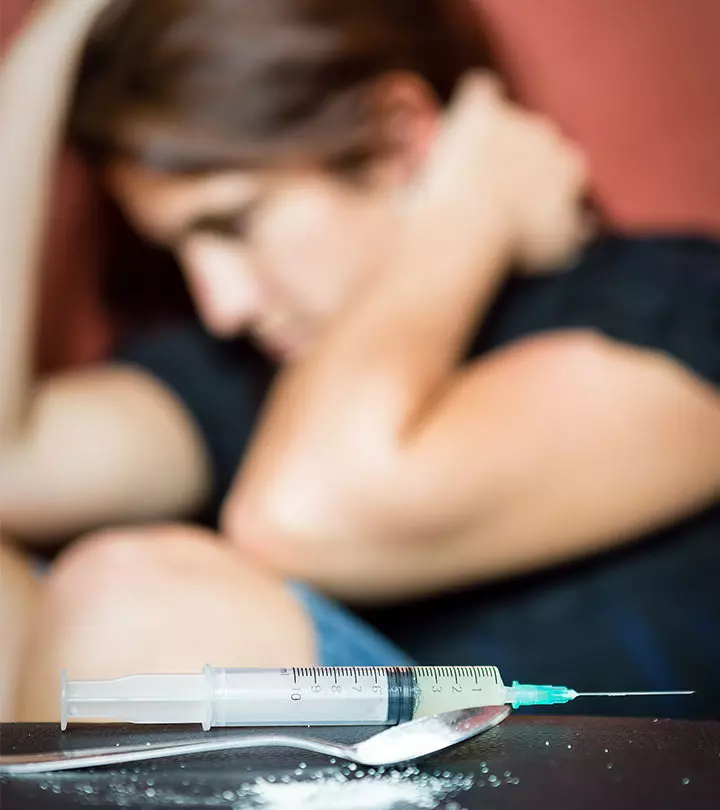Opioid And Opiate Withdrawal – Symptoms, Causes, And Treatment

Image: Shutterstock
Did you know that more than 130 people in the United States die every day after overdosing on opioids (1)? Opiates or opioids are mind-altering natural compounds derived from the resin of the poppy plant. Does the term ‘heroin” sound familiar? Well, it is also an opioid.
Opioids were prescription drugs used for pain management. But people started abusing these drugs over time due to the ‘high’ they gave. Once the body becomes addicted to it, withdrawal from the drug is challenging. What happens when your body stops receiving such opioids after a period of abuse? How bad are the Opiate withdrawal symptoms, and how can you manage them? Find answers to all these and more right here. Read on.
Table Of Contents
- What Is Opioid Withdrawal?
- Types Of Opioids
- Signs And Symptoms
- What Causes Opioid Withdrawal?
- Risk Factors
- How Is Opioid Withdrawal Diagnosed?
- What Are The Treatments Available For Opioid Withdrawal?
- Alternative Treatments
- Opiate Vs. Opioid
What Is Opioid Withdrawal?
Opioids and opiates are drugs that are used for the treatment of pain. The term ‘narcotic’ is also often used to describe these types of drugs. Heavy use of such drugs for a few weeks or more continuously might lead to withdrawal symptoms when you stop using them. This is referred to as opioid and/or opiate withdrawal (2).
These drugs usually work by mimicking endorphins, which are chemicals in the brain that act as natural pain relievers. Opioids are usually derived from the resin of the poppy plant. These drugs can also be prepared in a laboratory. They function by binding to the specific opioid receptors in the central/peripheral nervous system and the gastrointestinal tract.
There are illegal opioids (such as heroin) as well as legal opioids that are prescribed for relieving pain (like hydrocodone). In fact, those who become addicted to prescription opioids often end up using heroin as it is cheaper.
Opioids are classified into three types.
Types Of Opioids
- Natural Opiates – These are alkaloids that are nitrogen-containing base chemical compounds, which occur naturally in plants like the opium poppy. Drugs like Morphine, Codeine, and Thebaine are natural opiates.
- Semi-Synthetic Or Man-Made Opioids – They are made in the laboratory from natural opiates. Such opioids include Hydromorphone, Hydrocodone, and Oxycodone. Heroin is also a semi-synthetic opioid made from morphine.
- Fully Synthetic Or Man-Made Opioids – These are completely man-made and created from scratch. Synthetic opioids include Fentanyl, Pethidine, Levorphanol, Methadone, Tramadol, and Dextropropoxyphene.
Doctors often prescribe opioids like Morphine, Codeine, and Oxycodone to treat pain and provide relief. However, some individuals end up using these drugs as they are known to produce a “high” or feeling of euphoria. This has also led to overdose death.
The following are the withdrawal symptoms exhibited by those who stop taking opioids after weeks or months of abuse.
Signs And Symptoms
The early signs and symptoms associated with opioid withdrawal are (3), (4):
- Anxiety
- Craving
- Muscle aches
- Sweating
- Frequent yawning
- A runny nose
- Increased tearing
- Agitation
- Insomnia or sleeplessness
The late symptoms that surface with opioid withdrawal are (4):
- Diarrhea
- Abdominal cramps
- Vomiting
- Nausea
- Goosebumps
- Dilated pupils
These symptoms can be very uncomfortable and usually begin within 12 hours of the last heroin use or 30 hours of the last methadone use.
What causes these symptoms? Let’s find out in the next section.
What Causes Opioid Withdrawal?
Opioids usually cause physical dependence over time (if abused). The individual in question may end up relying on the drug to prevent the symptoms of withdrawal (2).
It is also important to note that, over time, more dosage of the drug is required to produce the same effect. This is referred to as drug tolerance.
However, the time taken to become physically dependent on these drugs may vary from person to person. When the individual decides to stop abusing the drug, their body takes time to recover. This causes withdrawal symptoms. Such symptoms can surface any time when the long-term use of opioids is suddenly stopped or cut back (2).
Some factors can also put you at a higher risk of opioid addiction.
Risk Factors
The risk factors for opioid addiction and the consequent withdrawal symptoms are:
- Taking opioids continuously for more than a few days
- Taking more than the prescribed dose of opioids
- A family history of substance abuse
- Young age and friend circle
- Emotional trauma from varying factors like unemployment, family or personal issues, etc.
- A history of criminal activities
- Heavy use of tobacco or other drugs
- A history of severe depression and/or anxiety
- Prior alcohol/drug rehabilitation
Even factors like the type of crowd you hang out with or being too young to understand the consequence of drug abuse can put you at a higher risk of opioid addiction.
If the withdrawal symptoms are uncontrollable, it is best to seek medical intervention as not quitting the drugs can put your life at risk.
How Is Opioid Withdrawal Diagnosed?
Your doctor or healthcare provider will begin by performing a physical examination. They may also ask about your medical history or history of drug abuse.
There is no specific diagnostic test for opioid withdrawal. Following a physical examination and/or assessment of the medical history of the patient, a urine or blood test may be suggested to confirm the use of opiates (5).
Depending on the other concerns of your doctor, a few additional tests may be recommended. They include (5):
- Liver function and blood chemistry tests like CHEM-20
- Complete blood count (CBC) test to help measure your different blood cells
- An X-ray of your chest
- Electrocardiogram (ECG) or heart tracing
- Testing for other medical conditions like hepatitis C, HIV, or tuberculosis as most individuals who abuse opiates are often found to have these conditions.
Once opioid abuse is confirmed, your doctor may discuss the treatment options to tackle the withdrawal symptoms once the drug usage is stopped.
What Are The Treatments Available For Opioid Withdrawal?
Facing withdrawal symptoms on your own can be quite dangerous. Treating opioid withdrawal symptoms includes a combination of medicines, support, and counseling.
At-home management can be quite difficult and should be done slowly and cautiously.
Treatment can also be carried out in a setup with facilities to help in the detoxification of the affected individuals.
If the symptoms are severe, the treatment is carried out in a hospital under the supervision of a medical professional.
Medications that help relieve opioid withdrawal symptoms are (6):
- Methadone – It relieves withdrawal symptoms and also helps with detoxification.
- Buprenorphine – It alleviates withdrawal symptoms and also shortens the length of detox.
- Clonidine – It helps with symptoms of anxiety, agitation, sweating, muscle aches, and cramping.
- Naltrexone – It can help prevent a relapse and is available in the form of pills as well as injections.
- Vitamin B and C supplements
It is enormously helpful if the affected individuals seek solace in support groups for opiate addicts. More details about alternative treatments for addressing opiate withdrawal are provided below.
Alternative Treatments
Most patients require long-term treatment post detox. This may include:
• Outpatient counseling
• Self-help groups, like Narcotics Anonymous or SMART Recovery
• Inpatient treatments and intensive outpatient treatments like day hospitalization
• Cognitive behavioral therapy that works towards modifying negative thoughts, feelings, or behavior. It may include activities like reading a book or simply going for a swim. Talking to a close friend or family also helps (7).
• Contingency management that provides the patients with a reward following every drug-free urine sample collected.
Individuals battling opioid withdrawal are often found to be suffering from other mental conditions like depression. Addressing and treating these disorders can also reduce the risk of a relapse to a great extent.
If you have noticed, the term opioids and opiates are often used together in some places. Is there any difference between the two or are they the same drugs? Let’s find out.
Opiate Vs. Opioid
Opiate is a pharmacological term for natural, mind-altering compounds with medicinal benefits found in opium. Sometimes, this term may also be used to refer to semi-synthetic compounds derived from these natural substances. Opium is the resin obtained from the opium poppy plant.
On the other hand, opioid is a modern term used for all compounds that act on the opioid receptors in your body, and it includes all opiates as well as fully synthetic compounds.
Withdrawing from opium can be one of your worst nightmares come true. Hence, seek medical intervention if you have been involved in substance abuse or want to withdraw from it. Be aware of the consequences of drug abuse and spread the knowledge you have to prevent others from falling prey to such habits.
Hope this post helps you or a close one who has been battling opioid addiction or withdrawal symptoms. Share your thoughts about this in the comments below.
Frequently Asked Questions
When to call a doctor for opioid withdrawal?
If you have been taking opioids or other such drugs only to find that you are now addicted to them, don’t waste any time in seeking medical intervention. Those willing to stop taking opioids or those who have begun facing the withdrawal symptoms should also see a doctor immediately.
Does Gabapentin help with opiate withdrawal?
Yes, Gabapentin can help with opiate withdrawal by helping in the detoxification process (8). However, even though this drug is found to be helpful in treating opiate withdrawal symptoms, it is associated with many side effects. Hence, talk to your doctor to come up with the best treatment plan for you.
How long does opiate withdrawal last?
The symptoms of opiate withdrawal may begin within 12 hours of the last dose, and for long-acting opiates, the symptoms may take up to 30 hours to surface. Over the following two days, the symptoms will continue to worsen until they become worse around the 72nd hour. By the time the third day comes to an end, most of the physical symptoms resolve. The accompanying psychological symptoms, as well as the cravings, may continue to last for a week or more.
References
- “Opioid Overdose Crisis” National Institute on Drug Abuse.
- “The Neurobiology of Opioid Dependence: Implications for Treatment” Science & Practice Perspectives, US National Library of Medicine.
- “The relationship between craving, anxiety, and other symptoms in opioid withdrawal.” Journal of Substance Abuse Treatment, US National Library of Medicine.
- “Opium Withdrawal Delirium: Two Case Reports” Psychopharmacology, US National Library of Medicine.
- “Opioid, Withdrawal” StatPearls, US National Library of Medicine.
- “Withdrawal Management” World Health Organization 2009, US National Library of Medicine.
- “Cognitive-Behavioral Therapy for Substance Use Disorders” The Psychiatric Clinics of North America, US National Library of Medicine.
- “Importance of gabapentin dose in the treatment of opioid withdrawal.” Journal of Clinical Psychopharmacology, US National Library of Medicine.

Community Experiences
Join the conversation and become a part of our vibrant community! Share your stories, experiences, and insights to connect with like-minded individuals.













